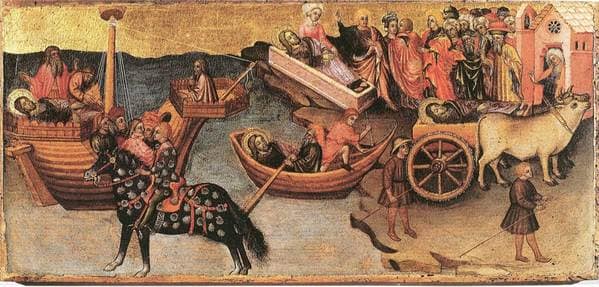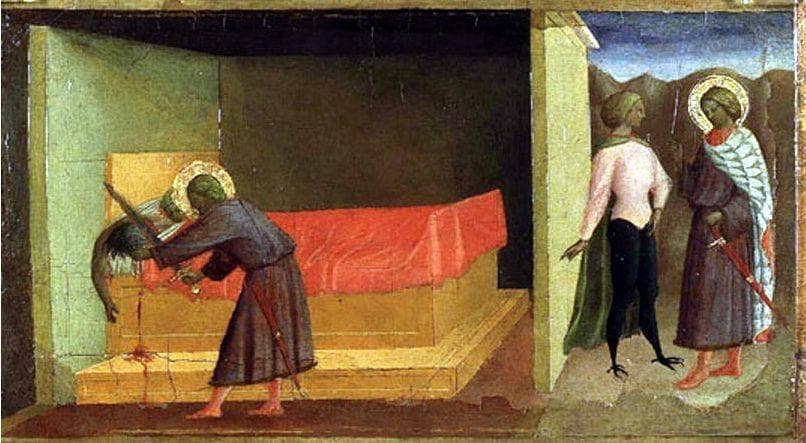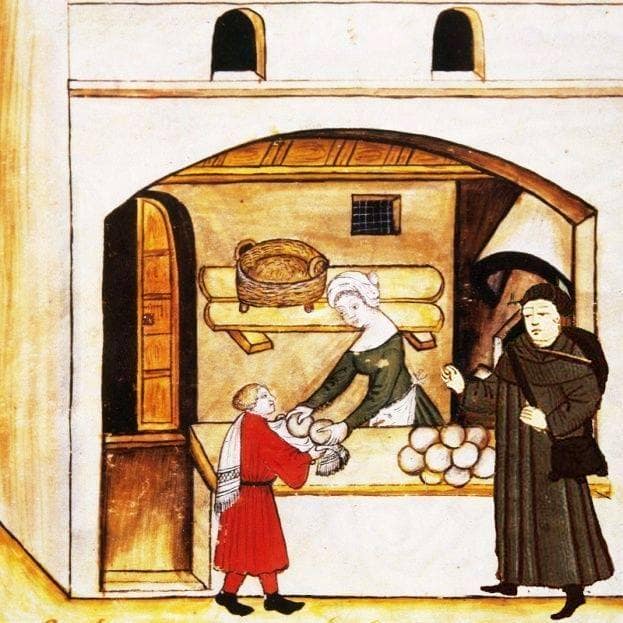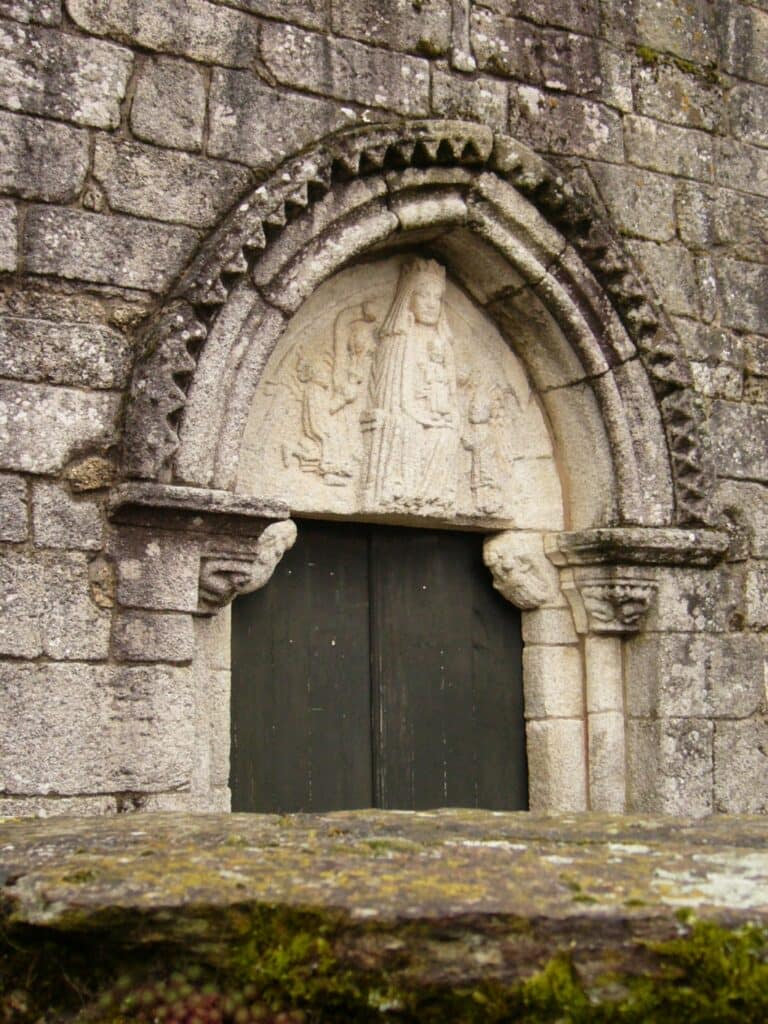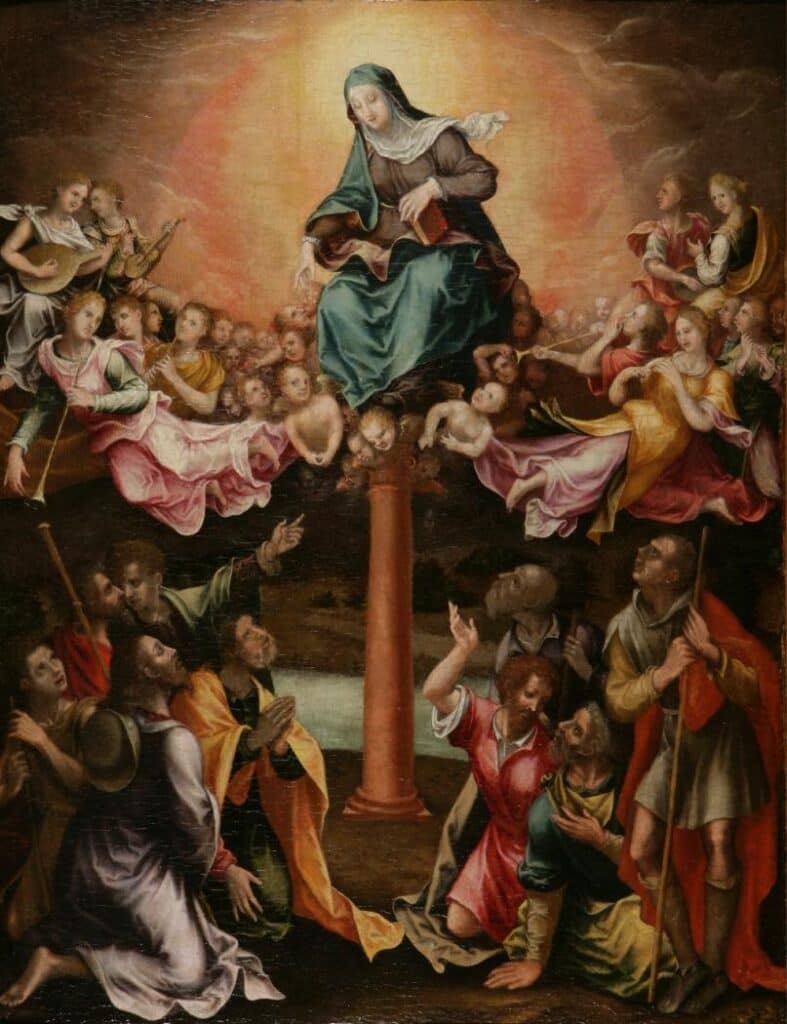A collection of stories that took place along the Camino de Santiago
The Legend of the Origin of the Pilgrim’s Scallop Shell
The story took place in the year 44 A.D. at Bouzas, which is on the Galician coast near the city of Vigo.
As Santiago’s disciples were arriving to the Galician coast with the remains of the saint, a groom was celebrating his wedding at Bouzas by playing a game called abofardar. The game consisted in throwing a spear into the air and then galloping on your horse to retrieve it before it fell to the ground. Caught up in the game, the groom galloped into the sea chasing his spear and disappeared under the waves. Luckily for him, this all happened at the moment the ship carrying Santiago’s remains was passing by.
Santiago’s disciples understood that the groom’s rescue had been a miracle as both the rider and his horse miraculously resurfaced from the sea, covered in scallop shells. Recalling this event, centuries later pilgrims associated the scallop shell with Santiago and started wearing them.
The Legend of Saint Julian Hospitaller
Saint Julian was tricked by the devil (in the painting below, the figure to the right with claws as feet) into believing his wife was in bed with her lover. Saint Julian, in a bout of anger, kills the two people in his bed who turn out to be his long lost parents who had spent years searching for him.
His parents had been searching for him as Saint Julian had left home years before after learning that he was destined to kill his parents. His parents were in his bed was because his wife, having discovered their identities, told them to rest there while she went to fetch water.
The painting must be read as a cartoon, the person in the room is the same person talking to the devil.
In penitence, Saint Julian goes to Rome with his wife to ask forgiveness from the Pope who absolves him under the condition that he spend the rest of his life caring for pilgrims on their way to Santiago de Compostela, hence the nickname: ‘Hospitaller’.
The Legend of the Pilgrim and the Baker of Arzúa
Once upon a time there was a pilgrim on his way to Santiago who walked by a house in Arzúa from which came the smell of freshly baked bread.
The pilgrim asked for a small piece of bread from the lady who was baking at that moment. She rudely replied that no. Upset, the pilgrim told her that she would be punished for not offering alms to a hungry pilgrim and that her bread would turn to stones. And they did.
Arzúa is one of the main towns pilgrims walk through just before Santiago de Compostela.
The Legend of King Witiza in Palas de Rei
Medieval Pallatium Regis (Royal Palaces), now Palas de Rei (Palace of the King), is believed to have been the site of of the Visigothic King Witiza’s castle. King Witiza died either in 710, the year before the Muslim invasion of Iberian Peninsula, or in 711. The Visigoths were the the dominant tribe that inherited the Roman Empire in Spain and Portugal when Rome collapsed.
It was here that King Witiza murdered Favila, the father of the future King of Asturias Don Pelayo, who would later become the first Christian king that was able to defeat and contain the advance of the Muslim armies in the north of Spain. At the time, only the northern region of Asturias remained Christian.
Witiza (aka. Witiza the Wicked) is the archetype of the evil ruler, or at least that is what history, tradition and legend has lead us to believe. He apparently had an uncontainable sensuous appetite and licentious passions, which led him to, not only have uncountable lovers and mistresses, but to also murder the husbands of women he happened to fancy. His regency was likewise marked by cruelty and tyranny.
Apart from from murdering Don Pelayo’s father, (no account is given of what happened to Don Pelayo’s mother who he was lusting after), he gorged out the eyes of Don Pelayo’s uncle, and willingly or (unwillingly) aided the Muslim armies (possibly not him but his brother, or half-brother, or perhaps his son…) with their invasion of the Iberian Peninsula.
Unfortunately, no trace of the palace, castle or Witiza remain.

The Legend of the Virgin of Santa María de las Nieves
Before there was a town or a church or anything in the village of Leboreiro (just before Melide), a spring suddenly appeared here, that was fragrant in the daytime and glowed at night. Logically, the local villagers assumed that something odd was taking place, so they decided to dig around the spring, eventually finding the statue of the Virgin that now rests on the altar inside the church.
In order to celebrate the miracle, they decided to build a church and move the statue to the church. However, each time they moved it, the following day they would find that the statue had mysteriously moved back to her resting place by the spring. After several attempts they came to the conclusion that perhaps they should have built the church over the spring. It was then that a local sculptor had the brilliant idea of reproducing the figure of the Virgin on the tympanum of the church (the one you see now).
And it appears that the Virgin statue liked this idea as she remained on the altar in the church once the image on the church’s tympanum had been completed. Tradition says that Our Lady still escapes on an occasion at night when it is pitch black to hto wash and comb her hair at her spring, returning to the church before dawn.
The Legend of Our Lady of the Pillar in Zaragoza
After leaving Galicia, Our Lady appeared to Santiago mounted on a stone pillar and instructed him to build a chapel, which became the first-ever chapel built to venerate Our Lady.
This happened by the Ebro River in the city of Zaragoza in Spain; and inside the Basilica of the Pillar you can still venerate the relic/pillar that was used by Our Lady.


